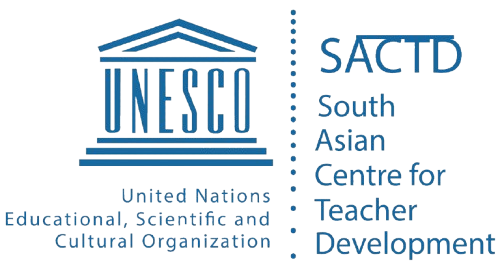
A Few words
Welcome to the South Asian Centre for Teacher Development
The South Asian Centre for Teacher Development (SACTD) is a UNESCO Category 2 Centre located in Meepe, Sri Lanka. Established under the auspices of UNESCO and the Government of Sri Lanka, SACTD is committed to enhancing teacher education across South Asia. Our mission aligns with Sustainable Development Goal 4, focusing on inclusive, equitable, and quality education for all.
SACTD Values…
SACTD will observe the following core-values in its day-to-day operations:
- Supportive and Responsive – We would be highly responsive and supportive, engaging, outward looking, stay relevant and observe professionalism and excellence in everything we do.
- Adaptability and Innovation – We believe that the change is a constant and therefore, we foster a culture of innovation and adaptability.
- Cooperation – We build strong networks and relationships collaboratively and we act, work, create and build together for the benefit of humanity.
- Trust and Integrity – We would be open, honest, positive and credible. We would do the right thing in the right way, in a transparent manner adhering to SACTD values that we strongly hold.
- Diversity – We embrace diversity and gender balance at all times and it is our habit getting to know and appreciate people of different cultures, religions, ethnic groups, socio-economic groups, or ages and liberate their potential and construct peace.
Corporate Goals…
SKRA 1: Education, Training and Development
Goal 1: Improved quality of Teacher Training and Development
Goal 2: 12,000 teacher trainers, mentors and counsellors be trained by end of 2027
SKRA 2: Research on Teacher Development and Training
Goal 3: New knowledge and dissemination of the new knowledge on Teacher development and training.
SKRA 3: Curriculum Development and Text Book Writing
Goal 4: Improved access to new curriculum and Text books on teacher development
SKRA 4: Open Distance Learning and Repository Services
Goal 5: Increased access to knowledge and skills to teacher trainers on open distance learning modes
Goal 6: Improved repository services to teacher trainers, policy makers and other stakeholders
SKRA 5: SACTD Centre of Excellence and Brand Building
Goal 7: Autonomy of SACTD and Brand Building:
Increased recognition and acceptance of SACTD by the educators in SAARC countries, the respective Governments and public sectors, educators, the teacher trainers and public.
Proposed Strategies
Goal 1: Improve the quality of Teacher-Trainer Training in SAARC countries
Main areas of focus are:
1.1: Offering practical, relevant and future education focused curricula, course work and teacher development programs;
1.2: Development of suitable and future focused curricula;
1.3: Offering attractive and teacher-trainer focused Teaching and Learning process:
1.4: Increasing access to teacher trainers for learning and following SACTD course work (e.g., On-line training);
1.5: Strong partnerships with other teacher training institutions (TTIs) for improving quality and coverage of subject matter;
1.6: Strong partnerships with teacher training institutions/training schools and education authorities for enhanced and secured clientele; and
1.7: Promote E-learning and e-pedagogy.
Strategies to achieve the above goal are:
i. Up-to-date technology in the SACTD class rooms (with proper equipment, use of computers by trainees, use of other tools such as Excel. MS Word. PPT etc.);
ii. Maintain the Curricula and course work in a most suitable, practical and attractive manner (revise, introduce and enhance. E.g.. New Courses to suit current needs);
iii. Enhanced access to curricula, course materials and all other materials;
iv. Improved quality of teaching and learning process at the teaching institutes;
V. Improved access to classes, education workshops and friendly atmosphere (e-learning, online classes, distance learning and seminars);
vi. Focus on improving trainers ability and skills in working with and use of IT;
vii. Standardization of courses with international institutions;
viii. Scheme of endowments / Scholarships; and
ix. Promotion, marketing and improved recognition.
Goal 2: Achieve training of 12,000 trainers and teachers during the next five years
Targets: 150 in 2023, 2,100 in 2024, 2,800 in 2025, 3,250 in 2026 and 3,700 in 2027
Main areas of focus are:
2.1: increased awareness of SACTD among leaching professionals and educational authorities.
2.2: Improved facilitation for registration, travel, accommodation etc.
2.3: Conduct of courses with an exceptional quality
2.4: Networking with schools, education authorities and education training providing institutions
2.5: Strong partnerships with other institutions
Strategies to achieve this goal are:
1. Promote SACTD among education authorities, training providers and private school management bodies;
2. Undertake a digital-social marketing campaign;
3. Scholarships and other assistance for needy trainers,
4. Improve awareness among teacher trainers;
5. Easing and facilitation of the registration process;
6. Training and courses conducted in other countries;
7. Networking with other institutions that provide teacher education courses and programs (E.g… Universities).
Goal 3: New knowledge and dissemination of the new knowledge on Teacher
Goal 4: Improved access to new curriculum and Text books on teacher development
SKRA 3: Curriculum Development and Text Book Writing
Goal 4: Improved access to new curriculum and Text books on teacher development
Main areas of focus are:
4.1: Development of new curricula and revision of existing curricula
4.2: Publicising and adoption
4.3: Review, feedback and revision/upgrading of curricula
4.4: Text book writing and publishing
Strategies to achieve this goal are:
i. Undertaking the needs assessment,
ii. Proper planning and resources allocation;
iii. Content development, pilot delivery and revision;
iv. Completed curriculum package and publicizing; and
V. Text book writing and publishing
SKRA 4: Open Distance Learning and Repository Services
Goal 5: Increased access to knowledge and skills to teacher trainers on open distance learning modes
Though the trainees prefer face-to-face education/training, online learning is beneficial for compensating for difficulties in travelling long distances or cost of travel and accommodation particularly travel between SAARC countries.
Main areas of focus are:
5.1 Development of online/distance learning courses and programs
5.2: Awareness and popularization of online / distance learning courses among the teacher trainers
5.3 Effective and efficient conduct of the online / distance learning courses and programs
5.4 Effective monitoring, feedback and evaluation on the above courses and programs
Strategies to achieve this goal are:
i. Development of online / distance learning courses and programs based on the specific needs of the trainers and educators in the SAARC countries;
ii. Increased awareness and knowledge about the above courses among the educators in SAARC countries.
iii. Effective and efficient delivery of courses and programs
iv. Monitoring, feedback and evaluation of the above courses and programs;
V. Periodical assessment, upgrading and revision; and
vi. Networking with institutions and outsourcing of leading online / distance learning courses of teacher trainer training
Goal 6: Improved repository services to teacher trainers, policy makers and other stakeholders.
Main area of focus is:
6.1: Develop SACTD digital platform for the repository
6.2 Improved access to research and other teacher-training, trainer training, and teaching related outputs
6.3: Effective dissemination of valuable/new research findings 6.4: Effective management of repository
Strategies to achieve this goal are:
i. Proper licensing and structural development (proper features and settings)
ii. Developing the SACTD repository to have access with an ability of providing information from leading international repositories and own SACTD knowledge base/knowledge products
iii. Developing proper policy framework for SACTD repository
iv. Increased networking with other leading repositories
V. Enhanced awareness, use and popularity of SACTD repository vi. Effective O&M on continuous basis and periodical upgrading of the same
SKRA 5: SACTD Centre of Excellence and Brand Building
Goal 7: Centre of Excellence and SACTD Brand Building Main areas of focus are:
7.1: Autonomy & legal status
7.2: Leasing of assets by NIE;
7.3: Increased recognition and acceptance of SACTD by the Industry, Public Sector, Students and the Government.
7.4: Improve relationships with key local, regional and international bodies and enhance Industry connectivity;
7.5: Increase the knowledge of the private sector and State sector management on use of Cost and Management Accounting theory and principles as a management tool, in their day-to-day functions;
7.6: Improved infrastructure and other facilities including and new building for SACTD;
7.7: Exemplary Customer Service at SACTD.
Strategies to achieve this goal are:
i. Incorporation of SACTD as a company limited by guarantee;
ii. Leasing of assets to SACTD by NIE:
iii. Effective marketing campaign;
iv. Promotion of SACTD in the private and public sector;
v. Review of job advertisements and follow-up on recognition of SACTD qualification;
vi. Promotion for international markets (SLBFE, foreign missions);
VII. Networking with key local, regional and international institutions;
viii. Promotion of success stories and best performers on mass-media;
ix. Effective use of annual conference, other events, SACTD web-site and social marketing; and
x. Research and studies and publications
xi. Development of infrastructure requirements (at H/Q) and other facilities (Library, Lecture-theatres and seminar facilities and Computer Centre/lab) to meet the future demands;
xii. Improved communication: Comprehensive web-site with all relevant information and other facilities such as e-learning facilities Web-based programs, online assessments, online registration, interactive sessions etc.;
xiii. Improved HRD/HRM at SACTD; (Training of SACTD staff);
xiv. Designing and institutionalizing sound internal control systems;
xv. Improved support services – Research and Studies Unit, Career Guidance Unit and Registration and Establishment Unit; and
xvi. Information systems and improved procedures (Academic Management Information System (AMIS), Monitoring and Evaluation (M&E) system etc. and internal procedures).

